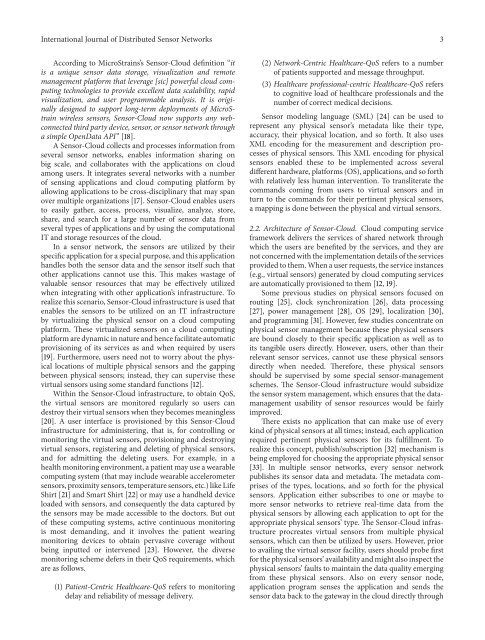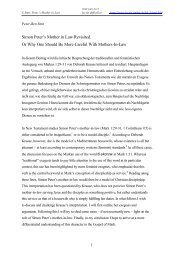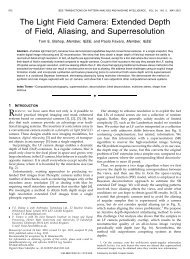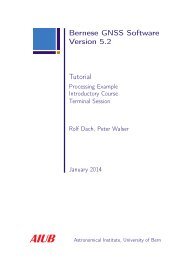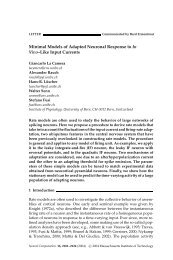Deploying Real-Life WSN Applications: Challenges ... - IAM - CDS
Deploying Real-Life WSN Applications: Challenges ... - IAM - CDS
Deploying Real-Life WSN Applications: Challenges ... - IAM - CDS
You also want an ePaper? Increase the reach of your titles
YUMPU automatically turns print PDFs into web optimized ePapers that Google loves.
International Journal of Distributed Sensor Networks 3<br />
According to MicroStrains’s Sensor-Cloud definition “it<br />
isauniquesensordatastorage,visualizationandremote<br />
management platform that leverage [sic] powerful cloud computing<br />
technologies to provide excellent data scalability, rapid<br />
visualization, and user programmable analysis. It is originally<br />
designed to support long-term deployments of MicroStrain<br />
wireless sensors, Sensor-Cloud now supports any webconnected<br />
third party device, sensor, or sensor network through<br />
asimpleOpenDataAPI”[18].<br />
A Sensor-Cloud collects and processes information from<br />
several sensor networks, enables information sharing on<br />
big scale, and collaborates with the applications on cloud<br />
among users. It integrates several networks with a number<br />
of sensing applications and cloud computing platform by<br />
allowing applications to be cross-disciplinary that may span<br />
over multiple organizations [17]. Sensor-Cloud enables users<br />
to easily gather, access, process, visualize, analyze, store,<br />
share, and search for a large number of sensor data from<br />
several types of applications and by using the computational<br />
IT and storage resources of the cloud.<br />
In a sensor network, the sensors are utilized by their<br />
specific application for a special purpose, and this application<br />
handles both the sensor data and the sensor itself such that<br />
other applications cannot use this. This makes wastage of<br />
valuable sensor resources that may be effectively utilized<br />
when integrating with other application’s infrastructure. To<br />
realize this scenario, Sensor-Cloud infrastructure is used that<br />
enables the sensors to be utilized on an IT infrastructure<br />
by virtualizing the physical sensor on a cloud computing<br />
platform. These virtualized sensors on a cloud computing<br />
platform are dynamic in nature and hence facilitate automatic<br />
provisioning of its services as and when required by users<br />
[19]. Furthermore, users need not to worry about the physical<br />
locations of multiple physical sensors and the gapping<br />
between physical sensors; instead, they can supervise these<br />
virtualsensorsusingsomestandardfunctions[12].<br />
Within the Sensor-Cloud infrastructure, to obtain QoS,<br />
the virtual sensors are monitored regularly so users can<br />
destroy their virtual sensors when they becomes meaningless<br />
[20]. A user interface is provisioned by this Sensor-Cloud<br />
infrastructure for administering, that is, for controlling or<br />
monitoring the virtual sensors, provisioning and destroying<br />
virtual sensors, registering and deleting of physical sensors,<br />
and for admitting the deleting users. For example, in a<br />
health monitoring environment, a patient may use a wearable<br />
computing system (that may include wearable accelerometer<br />
sensors, proximity sensors, temperature sensors, etc.) like <strong>Life</strong><br />
Shirt [21]andSmartShirt[22]ormayuseahandhelddevice<br />
loaded with sensors, and consequently the data captured by<br />
the sensors may be made accessible to the doctors. But out<br />
of these computing systems, active continuous monitoring<br />
is most demanding, and it involves the patient wearing<br />
monitoring devices to obtain pervasive coverage without<br />
being inputted or intervened [23]. However, the diverse<br />
monitoring scheme defers in their QoS requirements, which<br />
are as follows.<br />
(1) Patient-Centric Healthcare-QoS refers to monitoring<br />
delay and reliability of message delivery.<br />
(2) Network-Centric Healthcare-QoS refers to a number<br />
of patients supported and message throughput.<br />
(3) Healthcare professional-centric Healthcare-QoS refers<br />
to cognitive load of healthcare professionals and the<br />
number of correct medical decisions.<br />
Sensor modeling language (SML) [24] canbeusedto<br />
represent any physical sensor’s metadata like their type,<br />
accuracy, their physical location, and so forth. It also uses<br />
XML encoding for the measurement and description processes<br />
of physical sensors. This XML encoding for physical<br />
sensors enabled these to be implemented across several<br />
different hardware, platforms (OS), applications, and so forth<br />
with relatively less human intervention. To transliterate the<br />
commands coming from users to virtual sensors and in<br />
turn to the commands for their pertinent physical sensors,<br />
a mapping is done between the physical and virtual sensors.<br />
2.2. Architecture of Sensor-Cloud. Cloud computing service<br />
framework delivers the services of shared network through<br />
which the users are benefited by the services, and they are<br />
not concerned with the implementation details of the services<br />
provided to them. When a user requests, the service instances<br />
(e.g., virtual sensors) generated by cloud computing services<br />
are automatically provisioned to them [12, 19].<br />
Some previous studies on physical sensors focused on<br />
routing [25], clock synchronization [26], data processing<br />
[27], power management [28], OS [29], localization [30],<br />
and programming [31]. However, few studies concentrate on<br />
physical sensor management because these physical sensors<br />
are bound closely to their specific application as well as to<br />
its tangible users directly. However, users, other than their<br />
relevant sensor services, cannot use these physical sensors<br />
directly when needed. Therefore, these physical sensors<br />
should be supervised by some special sensor-management<br />
schemes. The Sensor-Cloud infrastructure would subsidize<br />
the sensor system management, which ensures that the datamanagement<br />
usability of sensor resources would be fairly<br />
improved.<br />
There exists no application that can make use of every<br />
kind of physical sensors at all times; instead, each application<br />
required pertinent physical sensors for its fulfillment. To<br />
realizethisconcept,publish/subscription[32] mechanismis<br />
being employed for choosing the appropriate physical sensor<br />
[33]. In multiple sensor networks, every sensor network<br />
publishes its sensor data and metadata. The metadata comprises<br />
of the types, locations, and so forth for the physical<br />
sensors. Application either subscribes to one or maybe to<br />
more sensor networks to retrieve real-time data from the<br />
physical sensors by allowing each application to opt for the<br />
appropriate physical sensors’ type. The Sensor-Cloud infrastructure<br />
procreates virtual sensors from multiple physical<br />
sensors, which can then be utilized by users. However, prior<br />
to availing the virtual sensor facility, users should probe first<br />
for the physical sensors’ availability and might also inspect the<br />
physical sensors’ faults to maintain the data quality emerging<br />
from these physical sensors. Also on every sensor node,<br />
application program senses the application and sends the<br />
sensor data back to the gateway in the cloud directly through


